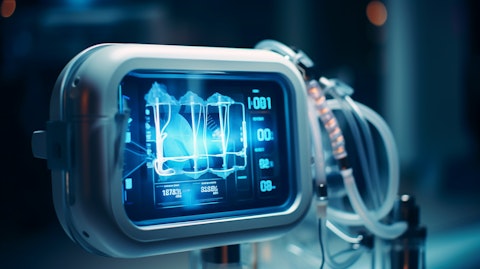Tivic Health Systems, Inc. (NASDAQ:TIVC) Q3 2025 Earnings Call Transcript November 14, 2025
Operator: Welcome to Tivic Health Systems third quarter 2025 financial results and operational update conference call. This call has been prerecorded. This call is being webcast, and the replay will be available on the IR of the company’s website for three months. Before we begin, let me remind you that during today’s call, management will make various forward-looking statements. Investors are cautioned that these forward-looking statements are based on current expectations and are subject to risks and uncertainties that could cause actual results or outcomes to differ materially from those indicated in our forward-looking statement. Please read the safe harbor statement contained in the press release that Tivic Health issued today as well as the risk factors contained in Tivic Health’s filings with the SEC, including its annual report on Form 10-K of the year ended 12/31/2024 and the Form 10-Q to be filed with the SEC today as well as other companies’ SEC filings.
Hosting today’s call is Jennifer Ernst, Tivic CEO, and Lisa Wolf, Tivic CFO. Now let me turn the call over to Jennifer Ernst. Thank you, and welcome to everyone listening today.

Jennifer Ernst: I’m pleased to be reporting on the progress we have made during the third quarter in building a new Tivic. As many of you know, at the start of the year, we undertook a significant strategic transformation of Tivic Health Systems, Inc. Beginning in February, with the licensing of entolimod and related assets, we expanded from bioelectronics to biologic pharmaceuticals with a common focus on the immune system and the ways we can harness the immune system to improve clinical outcomes and save lives. We’ve accomplished a great deal in a very short time. In Q2, we built out the team and secured the first meetings with potential customers for Entelimod’s use as a military countermeasure. We continue to deepen those connections and expect to be meeting with BARDA in the coming months to discuss stockpiling opportunities.
While our commercial focus is squarely on moving Intaloupe through our first BLA with the FDA for acute radiation syndrome, we’ve also continued to enrich our pipeline. We licensed Entelimod and Entelasta for neutropenia and have begun discussions with leading institutions about conducting investigator-led studies in this area. We have filed new intellectual property, IP that supports the potential use of our TLR5 agonist as adjunctive therapies for immuno-oncology cancer therapeutics. We have completed the optimization study for our VNS device design, uncovering the key parameters that have the strongest influence on the autonomic nervous system activity. And we are completing the exit from the consumer health market, increasing focus on prescription therapeutics.
Today, let me focus more on our fully licensed entolimod portfolio and report to you where this drug candidate stands from a clinical development perspective. Entalimod itself is a first-in-class late-stage, highly derisked drug candidate. And the first commercial opportunity for Tivic Health Systems, Inc. with entolimod is for acute radiation syndrome, which we are developing as a potential military stockpile drug. Entolimod for ARS is intended to be used as a countermeasure to exposure from lethal levels of ionizing radiation. Entelimod is of strategic value because its novel mechanism of action gives it the potential to treat radiation and cause damage to the GI tract, unlike the G CSF drugs that are currently stockpiled for ARS. We’re focusing our efforts on building relationships with U.S. and allied governments and on entolimod’s manufacturing readiness.
Q&A Session
Follow Tivic Health Systems Inc. (NASDAQ:TIVC)
Follow Tivic Health Systems Inc. (NASDAQ:TIVC)
Receive real-time insider trading and news alerts
Following the feedback we received from speaking with military officials at the Military Health System Research Symposium, and with the support of BARDA stakeholders, we requested a TechWatch meeting. Participating in a TechWatch meeting with BARDA and its interagency partners would give us further opportunity to discuss their interest in Entolimod for ARS and in the follow-on molecule Entelasta. Also this quarter, we completed the transfer of two entolimod INDs from Strattera to Tivic Health Systems, Inc. They cover the development of entolimod for ARS and for advanced cancer. The transfer of these INDs enabled us to move forward with entolimod clinical programs in neutropenia and lymphocyte exhaustion. With existing human safety data and prior dosing studies, we anticipate being able to move directly into Phase II clinical studies in both of these indications.
We believe our TLR5 mechanism of action could yield a wider range of clinical benefits than the approved colony-stimulating factor or G CSF class of drugs. Importantly, this includes addressing radiation-caused and chemotherapy-caused damage to the GI tract. Specifically, the G CSF drug class stimulates new blood cell formation only, whereas Tivic Health Systems, Inc.’s TLR5 mechanism of action engages a pathway that prevents cell death, a mechanism that can unlock benefits across multiple organ systems, including the GI tract. Prior studies have shown that entolimod has the potential to be used prior to exposure, for example, in advance of a medical radiation treatment, to protect critical cells responsible for white blood cell production and the epithelial lining of the GI tract.
These features of Entelimod open opportunities in the oncology space, and these INDs enable us to conduct clinical trials in these oncology-related applications. I’m also pleased to report the successful verification of the entolimod cell line. Working with our contract manufacturing organization, we successfully produced new Entelimod proteins. In vitro testing verified that the resulting protein structure and yields are suitable to move into larger batch production. This representative first production of any form of biologic represented a major manufacturing milestone that advances us along the path to current good manufacturing practices, or CGMP. Now CGMP is a required step in preparing for the biologics license application. Unfortunately, the contract manufacturer with whom we have been working has experienced financial stress in the wake of government actions earlier this year, actions that impacted several of their customers’ programs.
So while this has resulted in delays to our original schedule, we are working closely with the team and with our investors to establish stability and traction. At the same time, we’ve made good progress with other manufacturing partners to ensure we are able to meet our timelines and production requirements. And now just a few updates turning to our VNS program. This week, we announced the results of the findings from the optimization trial for our noninvasive vagus nerve stimulation program. The study served to isolate parameters that most significantly impacted autonomic system activity. And, admittedly, we had some surprise findings, ones that suggested we may be able to influence both sympathetic and parasympathetic activity, whereas our prior work had focused solely on the parasympathetic effects.
Learning may cause us to reassess the initial commercial focus that we were targeting. Now our findings are particularly compelling because they advance the field of neurostimulation. Personalization of the stimulation frequency, the lateral placement of the stimulation electrodes, and the duration of treatment all impact the clinical outcome, and not necessarily in the expected ways. While modern implanted devices are often utilizing real-time data to tune treatment, our study confirmed the hypothesis that VNS stimulation parameters delivered noninvasively can benefit significantly from personalization as a means to increase responder rates and increase the clinical effects. Because of the greater understanding gained from this trial, we are evaluating alternative commercial opportunities that could be enabled.
Now the program has taken a little bit of a backseat this year with our limited resources committed predominantly to the integration of our lead biologics candidate and its follow-on applications in oncology. We remain confident, though, that our noninvasive VNS approach has the potential to deliver clinical outcomes similar to or better than those of surgically implanted vagus nerve devices. And at this point, I’d like to ask Lisa Wolf to review the financial results for the quarter. Thank you, Jennifer.
Lisa Wolf: For ease of listening, all of the financial metrics I will be comparing the third quarter ended 09/30/2025, to the prior year quarter ended 09/30/2024. And the nine months ended 09/30/2025, to the nine months ended 09/30/2024 unless otherwise stated. Financial results for the third quarter and first nine months of the year reflect our transition as a company with our focus towards the biopharmaceutical market and away from the consumer device market. As mentioned in our last quarterly call, we plan to exit the consumer device market by the end of the year. Toward that end, during the third quarter, we recorded reserves for excess and obsolete inventory of $230,000, which is included in the cost of goods sold. We also wrote off certain assets related to clear up, with a net book value of $117,000, which is included in other expenses.
We do not expect to incur additional significant costs associated with our exit from the consumer device business. Additionally, we have now discontinued the allocation of any significant resources toward clear up sales. As part of this progression, the company launched a new corporate website that puts the emphasis on our transformed mission and expanded clinical pipeline. Revenue net of returns totaled $140,000 for the quarter, compared to $126,000 in the year-ago quarter. Revenue net of returns totaled $302,000 for the nine-month period compared to $600,000 in 2024. The increase in the quarter was a result of increased unit sales, driven by reduced selling prices as we push to reduce prior to exiting the business. The decrease for the nine-month period was primarily due to decreased unit sales resulting from reductions in our advertising spend as we focused our resources on the advancement of our TLR5 program.
Cost of sales increased to $291,000 from $82,000 in the year-ago quarter primarily due to the $230,000 of inventory reserves recorded in 2025. Cost of sales decreased to $343,000 from $359,000 for the nine-month period primarily due to lower unit sales offset by the $230,000 inventory reserve. Gross margins, excluding the $230,000 inventory reserve, were 42% for the third quarter, compared to 35% for the year-ago quarter. Gross margins excluding the $230,000 inventory reserve were 37% for the nine-month period compared to 40% for the year-ago quarter. Operating expenses were $2,300,000 for 2025 compared with $1,500,000 for the same period in 2024. Operating expenses for the first nine months of 2025 were $5,900,000 compared to $4,400,000 for the first nine months of 2024.
The increases for the quarter were due to increased research and development investments in our biologics program, increased corporate costs, and increases in advertising costs per ClearApp as we push to sell through that inventory prior to our exit from the consumer business. The increases for the nine-month period were primarily due to increased research and development investments in our biologics program and increased corporate costs offset by reductions in sales and marketing costs for CLEAR as we focused our resources into the advancement of the TLR5 program. Net loss was $2,600,000 for 2025 compared with $1,400,000 for 2024. Net loss for the nine-month period of 2025 was $6,000,000 compared with $4,200,000 for the same period in 2024.
At 09/30/2025, cash and cash equivalents totaled $3,500,000 compared with $2,000,000 at 12/31/2024. We believe that these funds, along with remaining planned tranches of our preferred purchase agreement, will allow us to make meaningful progress toward GMP manufacturing validation for entolimod, which is a key value inflection point for the company. There’s also no debt on the balance sheet. And with that, I’d like to turn the call back to Jennifer for closing remarks.
Jennifer Ernst: Thank you, Lisa. So to recap, we started a process in February to transform the business. And today, this transformation is well underway. In the third quarter and subsequent weeks, we’ve transferred two INDs to Tivic Health Systems, Inc., completed the cell line verification required to enable a future BLA with the FDA, wound down the consumer health tech business, advanced discussions of potential pathways to deploying entolimod as a military countermeasure and stockpile drug, and last but not least, we closed additional tranches of the company’s $8,400,000 financing for a total of $3,800,000 in net proceeds during the third quarter. So yes, the transformation progress is well underway. And I want to thank you for listening and for your continued interest in Tivic Health Systems, Inc.
We look forward to continuing our progress in the coming weeks and months as we focus on advancing value creation activities on behalf of our shareholders, while at the same time working to bring life-saving and life-enhancing treatments to patients in need. And with that, I’ll turn the call back to the operator. Thank you.
Operator: This will conclude today’s conference. You may disconnect your lines at this time, and have a great day. Thank you for your participation.
Follow Tivic Health Systems Inc. (NASDAQ:TIVC)
Follow Tivic Health Systems Inc. (NASDAQ:TIVC)
Receive real-time insider trading and news alerts




